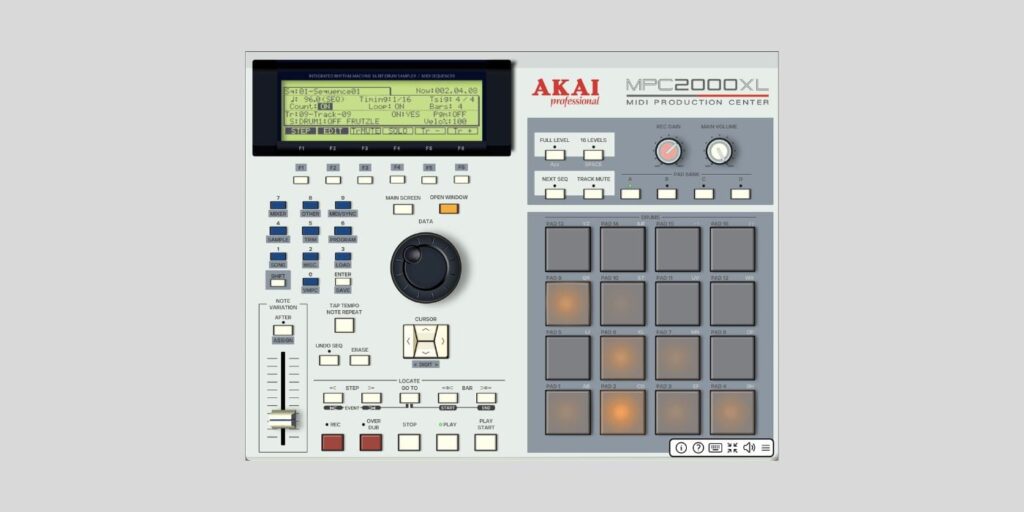VMPC2000XL is an unofficial Akai Professional MPC 2000XL emulation for macOS, Windows, and Linux.
While Akai Professional doesn’t endorse the emulation in any way, I have to say, it looks fantastic, and captures the retro character of the iconic MPC hardware perfectly.
VMPC2000XL isn’t new; in fact, Tomislav covered it way back in April of 2020, but it now utilizes the JUCE framework and should deliver a better user experience than before.
I missed VMPC2000XL the first time around, and was instantly excited by the thought of an MPC 2000XL on my screen. But, if you’ve tested this emulation before, it’s a good chance to find out how this JUCE implementation performs, and if all previous bugs have been vanquished.
I’m on macOS 14.5 with Logic Pro 11.0.1, and I’ve not encountered any functionality issues yet. Please share any problems with other systems and DAWs in the comments.
The first thing that struck me, after loading VMPC2000XL, was the attention to detail in the GUI. For example, the pads don’t illuminate in a perfect square; instead, they light up like a real backlit pad, showing signs of wear and tear.
The famous MPC workflow is typically regarded as the most significant appeal of any MPC unit, but people still debate the distinct sound of a particular model. Some people will tell you that it’s nothing to do with sound, and all about workflow, but older models, like the MPC 2000XL, do have something slightly different. You could simplify it as lacking the clarity and crispness of newer models, but it works for old-school hip hop beats.
However distinct (or not) you find the sound, part of the charm of the MPC2000XL is a simple dynamic low-pass filter, which you can apply per voice/pad, and this emulation mimicks it well. Although you don’t get a complete signal path emulation, the filter controls (found on the Program screen) give some of that 1990s/early 2000s vibe.
The interface mirrors the hardware, and all familiar controls are present and working, including:
- Four pad banks
- Full Level
- Tap Tempo and Note Repeat
- Function Buttons
- Note Variation Slider
- Transport Controls
- Wheel and Cursors
You’ll need to hold the shift key on your computer keyboard to access the blue buttons (Mixer, Program, Sample, etc.). You can trim and manipulate every sample, as you would do on a hardware unit.
You might be wondering what you have to gain by using VMPC2000XL; after all, if you want something like the MPC workflow, you could look at the free MPC Beats DAW, which is more advanced and flexible.
However, VMPC2000XL delivers the classic MPC workflow as well as you can in software form, and its limitations are part of the charm. Sometimes it’s good to remove distractions and get back to basics, which is why so many producers still chase pristine vintage hardware units.
If you want to use a hardware pad controller with VMPC2000XL, and the pads don’t align properly, you can adjust the setup via the VMPC button.
VMPC2000XL provides a lovely nostalgia trip for past and current MPC users while giving MPC newbies a virtual taste of the real thing. It’s also a valid way to make a beat the old way (well, the somewhat old way).
I’m a huge MPC fan, but I’ve never owned an MPC 2000XL, so this emulation is a lot of fun for me. I currently use an MPC X and MPC Studio controller, which is a great buy if you want something lightweight to travel with.
I’ve been promising to get back to MPC content, and for tedious reasons, it hasn’t happened yet. But, I do have something in the pipeline, and it will include some freebies from the awesome Mode Audio (check out their exclusive BPB sample pack to use with VMPC2000XL).
VMPC2000XL is available in AU, VST3, LV2, and Standalone formats for macOS, Windows, and Linux.
Download: VMPC2000XL
More:
Last Updated on September 8, 2025 by Tomislav Zlatic.




